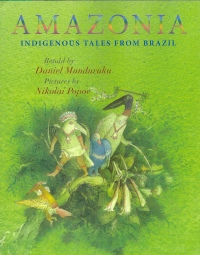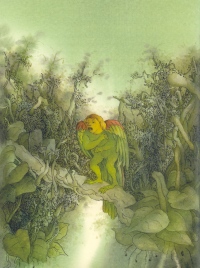| ________________
CM . . .
. Volume XIX Number 31. . . .April 12, 2013
excerpt:
An attractive package, or repackaging as the case may be, of 12 indigenous tales from Brazil originally collected, illustrated and published in Russia. The original book, illustrated by Nicolai Popov, was long out of print when author Daniel Munduruku was asked to select and retell the tales from this academic collection he felt were most representative of the people of the Amazon. Twelve of Popov's softly coloured and evocative full page illustrations for the selected tales are included in this volume. Munduruku’s stories are simply, but eloquently, translated by Jane Springer. After providing the translation for the author’s introduction, Springer comments that: "These tales were passed on through a resilient oral tradition until many were written down in the late 1800s and early 1900s. The stories presented here by Daniel Munduruku are faithful to the original records." Unfortunately for this academic and storyteller, this is the only source note that is provided for the stories themselves, a slight quibble perhaps but a disappointment nonetheless. When the dance is done they are not two things any more. They danced around and shared so much that they became one brand new thing.
Reflective of the people and the environment, these tales have not been sanitized for young readers. The myths, pourquoi tales and folktales in the collection include murders, chaos, transformations, seductions, gluttony, and other universal situations and motifs but in a gentle way that is not intended to shock the reader or glorify the dangers inherent in the Amazon for its original inhabitants. These are tales that are real and breathe life into several cultures in this far and distant land. The retold tales include myths from the Munduruku, Manao, Bororo, Umutina, Apinajé, Terena, Tupi and Anambé peoples and range from just a few pages to much longer entries. All of the tales are easy to read aloud by young readers and would provide fodder for storytellers interested in telling the tales orally, bringing them full circle to their origins. Highly Recommended. Gail de Vos teaches at the School of Library and Information Studies for the University of Alberta and is the author of nine books on storytelling and folklore.
To comment
on this title or this review, send mail to cm@umanitoba.ca.
Copyright © the Manitoba Library Association. Reproduction for personal
use is permitted only if this copyright notice is maintained. Any
other reproduction is prohibited without permission.
NEXT REVIEW |
TABLE OF CONTENTS FOR THIS ISSUE
- April 12, 2013
AUTHORS |
TITLES |
MEDIA REVIEWS |
PROFILES |
BACK ISSUES |
SEARCH |
CMARCHIVE |
HOME |

 The stories are followed by a glossary of terms needed to fully understand and put into context terms not defined in the stories themselves. For example, in the excerpt above, the explanations for "golden dorado" is "a large river fish"; "pacu" is "an omnivorous freshwater fish related to the piranha"; and a "tetra" is "a small fish with a horizontal iridescent blue strip on each side."(94-95)
The stories are followed by a glossary of terms needed to fully understand and put into context terms not defined in the stories themselves. For example, in the excerpt above, the explanations for "golden dorado" is "a large river fish"; "pacu" is "an omnivorous freshwater fish related to the piranha"; and a "tetra" is "a small fish with a horizontal iridescent blue strip on each side."(94-95)